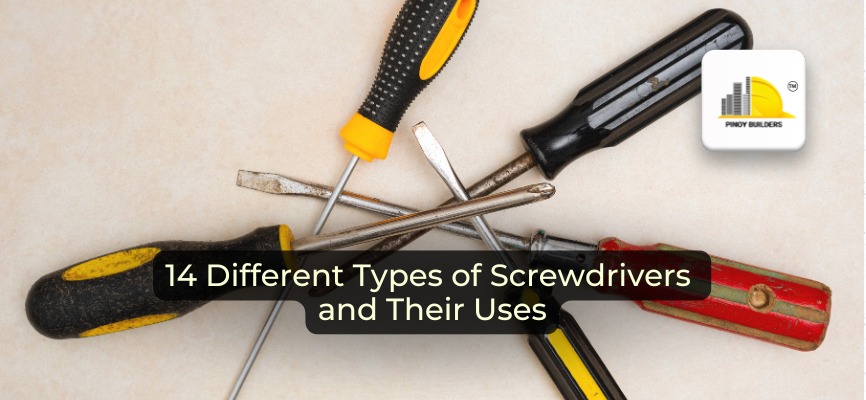Screwdrivers are one of the first tools a child is introduced to. They perform a simple function and have a very simple design. Or do they?
Most people have heard of at least two types of screwdriver, but there is actually a wide range to choose from. From the common Torx to the not-so-common tri-point, every shape has its own purpose. Let’s take a moment and explore 14 different screwdriver types and what they’re used for.
Common Screwdrivers
There are several types of screwdriver heads that are commonly needed for items around the house. There’s a good chance you already own some or all of these.
Slotted
Once the most popular of all screwdriver types, these screwdrivers have a chisel-shaped blade which spans the width of a screw’s head. They often double as a chisel in emergencies, and can also be sometimes used on a Phillips head screw.
Known for being less likely to round a slot than Phillips screwdrivers, the tip of these is sometimes prone to slipping sideways out of a slot when a lot of pressure is applied. For this reason, they’re not as popular among professionals as they once were, but are still a staple in most fields.
Phillips
Just about everything uses a Phillips head these days, from furniture to appliances. The angled tip means you can fit a screwdriver deeper into the screw head and there’s no risk of the blade sliding out sideways. These drivers are intentionally designed to cam out (i.e. slip out of the head when a certain torque limit is exceeded), which is considered both a strength and weakness.
Because of their usefulness, you’ll find Phillips screwdrivers in almost every field. While they will never fully replace slotted screwdrivers, they now tend to be the most preferred type of screwdriver and head combination and the best screwdriver sets will always include multiple Phillips screwdrivers.
Torx
Torx drives were originally used for security functions, but they’ve since become popular in commercial fields. The blades of these drives resemble a rounded off star or flower and provide incredibly high torque tolerances.
Currently, Torx drives are popular in appliance manufacturing and security fields due to their efficiency and the fact that consumers have a more difficult time taking apart an appliance that has Torx screws.
Hex
Another, more unusual type of screwdriver that has become increasingly popular, the hex key most commonly lacks a handle or tip. In most cases, they resemble a small, six-sided metal shank bent into an L-shape and lacking a head. They’re often included at no cost with packaged furniture.
Allen wrenches are most commonly used in bike maintenance, but have become increasingly popular with furniture companies such as Ikea and with some appliance manufacturers. A specialized security version of the hex key is used in high-risk fields, such as prison maintenance.
Hex screwdrivers take it up a notch by having a comfortable handle and a longer shank than their allen wrench counterparts.
Robertson
This is the least common of the common screwdrivers and tends to sit in the bottom of tool kits, but it’s actually popular in its native country (Canada) and has perhaps the highest torque tolerance of all drive types.
Because of its durability, square head screws are commonly found in automotive and furniture industries. They are frequently included in comprehensive screwdriver sets, and the increased popularity of international companies means that these screwdrivers will be seeing increased American usage in the years to come.
Other Types of Screwdriver
While there are plenty of variations in screw head types for just the four most common shapes (slot, cruciform, hex, and Torx), there are far more that you’ve likely never heard of. The following are some of the many more specialized screwdriver types you may run across. You’ll notice that the parts of a screwdriver are all very similar with the tip being the main difference.
Clutch Head
Clutch head screws have gone through a few design changes over the years. The slots resemble a bow-tie, with the older version having a circular recess in the middle. You will mostly find these screwdrivers in use throughout the automotive industry, being popular in recreational vehicles and older GM vehicles.
A clutch head screwdriver will have better torque with these heads, although they are designed to also be compatible with slotted drives.
There is also a security version that can be screwed one way with a slotted screwdriver but cannot be easily removed. These are found mostly in places where maintenance is infrequent, such as bus stations or prisons.
Frearson
This variation of cruciform is very similar to a Phillips at first glance, but has some important distinctions. The tip of a Frearson comes to a sharp point, whereas the Phillips has a rounded point. Additionally, the angle of the tip is closer to a 45 degree angle than on a Phillips. This makes it possible to use a single Frearson screwdriver on any size Frearson screw (as well as many Phillips screws).
The unique shape of a Frearson screwdriver allows for higher torque than a Phillips, and the ability to carry just one drive makes it very popular for nautical equipment and in other areas where precision and a smaller set of tools are required.
JIS (Japanese Industrial Standard)
Being one of the world leaders in technology requires uniformity and high standards. As a result, every major industrial field follows standards set my a special committee. JIS screwdrivers are a cruciform similar to Phillips but are designed to resist camming out.
You will find JIS screws in most quality products coming from Japan. It’s possible to use a Phillips or Frearson drive on these screws, but with an increased risk of damaging the head. JIS screws often have a small mark or dot near the slot to help identify them.
Nut Driver
Nut drivers are something a lot of DIYers never see, but they can be very useful in mechanical industries. These drives are designed with a socket instead of a blade and tip, thus acting in a similar fashion to a socket wrench.
The advantage of using a nut driver is apparent the moment you try reaching a recessed bolt. Socket wrenches have a handle which runs parallel to the surface in which the bolt is embedded, requiring additional space to turn. The straight shank and handle of a hex socket means that you can turn such bolts with very little clearance. Great for low torque applications but stick with the normal ratchet plus socket combo for everything else.
Pozidriv
Designed as an update of the Phillips design, Pozidriv screws can be identified by the four additional lines radiating from the center. These screwdrivers have a blunt tip and small ribs among the blade between the main edges. These improve torque and reduce the risk of cam out.
While Pozidriv and Phillips are very similar, the designs are different enough that their cross compatibility comes with an increased risk of damaging the screw head. Pozidriv screwdrivers have less chance of camming out, but the process for manufacturing screws requires twice as many steps, preventing them from replacing Phillips as an industry standard.
Spanner
Not to be confused with the British term, these unusual drivers are designed for tamper-proof functions. The flat-headed screws have two rounded holes on opposing ends of the head, making it nearly impossible to remove without a proper tool.
Due to their highly secure nature, you will most likely see maintenance workers using these screwdrivers in subways, bus terminals, elevators, or public restrooms. Spanner screwdrivers have a unique flat blade with two prong tips protruding from the end.
![]()











